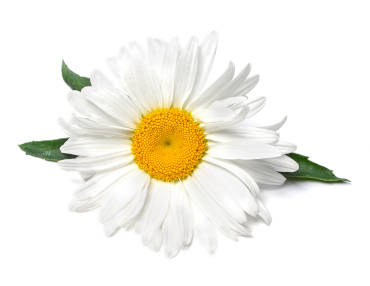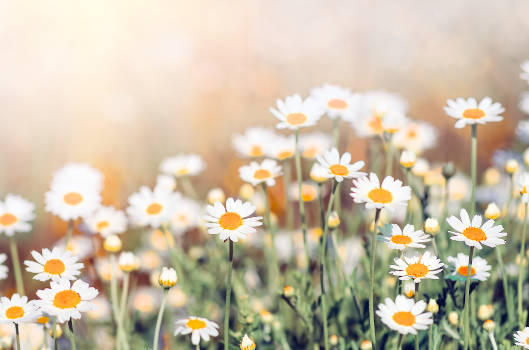The cheerful, daisy-like flowers of chamomile are well known as a relaxing herbal tea. Both German chamomile (Matricaria recutita) and Roman chamomile (Chamaemelum nobile) exhibit very similar properties, and are virtually indistinguishable after picking and drying.
In addition to being a staple in teas, these fragrant herbs are a mainstay of magic and medicine.
Magical Properties of Chamomile
Chamomile is an herb for luck, love, success, and prosperity. Many sources consider them a solar herb — unsurprising, considering their sunny yellow flowers with white petals, and the pale golden tea produced by infusing them in water.
For this reason, they are also sometimes used in formulas to break hexes and repel negative energy.
Washing the doors and windows of your home in a chamomile infusion will keep unwanted spirits or energy from sneaking in.
As a relaxant, chamomile makes a great addition to incense for meditation.
Add to herbal mixtures or spell jars for luck and money. If you’re a gambler, one practice from American folk magic calls for washing your hands in chamomile tea before playing cards.
Add chamomile to a ritual bath before casting a spell related to love, luck, or purification. To do this properly, make sure you’re clean before setting up the bath. Fill your tub with clean water, then add an infusion of chamomile flowers.
Stir it in a clockwise direction with your dominant hand. Step into the bath, and fully immerse yourself under the surface of the water. Allow your aura and body to absorb the energy of the chamomile.
When you are ready, exit the tub. If you don’t have a bath tub, you can fill a large basin or other container with a chamomile infusion and pour it over yourself in the shower — it works just as well.
Chamomile is usually regarded as an herb ruled by the Sun, though some sources attribute it to the Moon, Mercury, or Venus. It’s also ruled by the element of water.
See also: Check out Chamomile flowers here, and Chamomile essential oils here.
Benefits & Uses
Chamomile is a powerful relaxant — so powerful, in fact, that extracts of it have been used to sedate people undergoing cardiac catheterization.
The herb also acts as a gentle muscle relaxant, easing cramps and muscle pains. This includes the muscles of the gastrointestinal tract, which makes it a great remedy for stomach cramps. Its anti-inflammatory properties also make it useful against acid reflux, indigestion, and diarrhea.

Topically, it helps ease rashes and minor injuries. You can use a used chamomile tea bag as a quick and easy compress for minor skin ailments. Chamomile contains α-bisabolol, which is anti-microbial, as well as chamazulene and α-bisabolol, which are antiseptic.
Chamomile is rich in polyphenol compounds, including luteolin, quercetin, apigenin, and patuletin.
Possible Risks & Side Effects
Chamomile can trigger allergies, especially for those who are allergic to other members of the daisy family. Allergies can vary widely in severity, from rashes and mild, hay fever-like symptoms, to anaphylactic shock. If you are allergic to chamomile or any of its relatives, please use a different herb in its place.
For most people, chamomile is remarkably safe. It has a very long history of use in teas, and most people don’t experience any problems after consuming it. That said, it does have the potential to react with certain medications.
If you are currently taking anticoagulants, please consult your doctor before using chamomile. Some of the herb’s compounds can mimic the action of anticoagulants in the body, leading to bleeding problems.
If you use antihistamines, certain medications for depression or anxiety, painkillers, or other medication that can cause drowsiness, be aware that using chamomile can amplify this effect. Don’t try to drive or operate heavy machinery until you know how it will affect you.
History & Folklore
Chamomile comes from the Greek word “khamaimēlon,” which means “earth apple.” It most likely earned this name for its subtly fruity, apple-like fragrance.
This plant was part of the Nine Herbs Charm, an Anglo-Saxon poem that recounted a remedy for infections and poisonings.
The herbs in the charm were to be made into a salve by a healer, who would chant the charm three times over each herb, and into the mouth, ears, and wound of the person being healed.
In the charm, it’s said that “[…]never a man should lose his life from infection after Chamomile was prepared for his food.”
In Egypt, chamomile was associated with the Sun God Ra. Medicinally, it was used to relieve fevers.
Getting Started With Chamomile
Both varieties of chamomile are pretty easy to grow, even for novice green witches. Plant starts are readily available at most nurseries, but it’s not too hard to start these flowers from seed, either.
Roman chamomile is a low-growing (4-12″) perennial that is best propagated by division of mature plants. German chamomile is a taller (up to 20″) annual that is easily grown from seed.
If you avoid harvesting a few chamomile flowers and let them go to seed each year, your garden will never run out of these wonderful, fragrant plants.

Give it sandy, well-drained soil and anything from full sun to partial shade. If you live in a hot area, your plants will prefer having some shade to cool off under in the afternoon.
Both types of chamomile reach maturity at around 10 weeks. When the plants are in full bloom, cut the flowers and hang them to dry. Before long, you’ll have plenty of chamomile for making tea, infusing, making into tinctures, or adding to herb mixtures.
The easiest way to get starting working with chamomile is to prepare it as a ritual bath before spellwork. Ritual baths are a great habit to get into — they help you clear your mind for the task ahead, and act as a helpful bit of spiritual hygiene.
You can use an infusion of chamomile alone, or mixed with other herbs related to your intention. If you aren’t able to take a bath, that’s okay. Some witches wash their face and hands when a full ritual bath isn’t possible.
Chamomile isn’t just a helpful ally for humans — it’s beloved by pollinators and other plants, too.
Whether you choose to grow the herb yourself, or just work with it in its dried form, chamomile will soon become one of your favorite herbal ingredients.
As an Amazon Associate, Terravara earns from qualifying purchases at no additional cost to readers.
